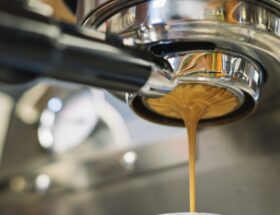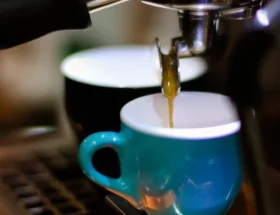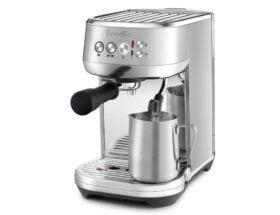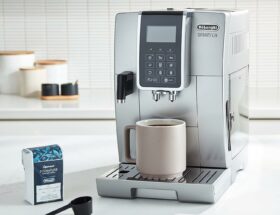
The Ultimate Guide to Making Espresso at Home
Espresso is a concentrated coffee drink that is made by forcing hot water through finely-ground coffee beans. It is a versatile drink that can be enjoyed on its own or used to make other coffee drinks, such as cappuccinos and lattes.
How to Make Espresso Like a Pro? Making espresso at home can be a bit tricky, but it is definitely possible with the right equipment and technique. In this blog post, I will share everything you need to know to make the perfect espresso at home.
Table of Contents
- How to Make Espresso
- Espresso Tips and Tricks
- Espresso Variations
- History and Origin of Espresso
- Essential Equipment for Making Espresso
- The Science Behind Making Espresso
- Specific Techniques for Achieving the Best Results
- The Importance of Coffee-to-Milk Ratios
- Creative Ways to Make Espresso Unique and Delightful
- Conclusion
- Invite to engage and leave a comment
How to Make Espresso
To make espresso, you will need an espresso mchine, finely-ground coffee beans, and hot water. The steps are as follows:
- Grind the coffee beans to a fine, consistent grind.
- Fill the portafilter with the ground coffee beans.
- Tamp the coffee grounds firmly into the portafilter.
- Place the portafilter in the espresso machine.
- Turn on the espresso machine and wait for the water to heat up.
- When the water is hot, press the button to start the espresso extraction.
- The espresso will extract for about 25-30 seconds.
- Once the espresso is extracted, you can pour it into a demitasse cup.
Espresso Tips and Tricks
Here are some tips and tricks for making the perfect espresso:
- Use fresh, high-quality coffee beans.
- Grind the coffee beans just before you make the espresso.
- Tamp the coffee grounds firmly into the portafilter.
- Use filtered water.
- Preheat the espresso machine before you start extracting the espresso.
- Adjust the grind size and tamping pressure until you get the desired espresso extraction time.
- Experiment with different types of coffee beans and roasts to find your favorite flavor profile.
Espresso Variations
Espresso can be enjoyed on its own, or it can be used to make other coffee drinks, such as cappuccinos, lattes, and macchiatos. Here are some popular espresso variations:
- Cappuccino: A cappuccino is made with espresso, steamed milk, and foamed milk.
- Latte: A latte is made with espresso and steamed milk.
- Macchiato: A macchiato is made with espresso and a small amount of foamed milk.
- Americano: An Americano is made with espresso and hot water.
History and Origin of Espresso
Espresso originated in Italy in the early 1900s. The first espresso machine was invented by Angelo Moriono in 1884. Espresso quickly became popular in Italy, and it spread to other parts of the world in the following decades.
Today, espresso is enjoyed by coffee lovers all over the world. It is a popular drink in cafes, restaurants, and homes.
Essential Equipment for Making Espresso
The essential equipment for making espresso at home includes:
- An espresso machine
- A grinder
- A tamper
- A portafilter
- A cup
Espresso machines come in a variety of prices, from budget-friendly models to high-end machines. When choosing an espresso machine, it is important to consider your budget and your needs.
A grinder is also essential for making espresso. The grinder should be able to grind the coffee beans very finely.
A tamper is used to press the coffee grounds into the portafilter. The tamper should be made of metal and it should have a flat surface.
A portafilter is a metal cup that holds the coffee grounds. The portafilter should fit into the espresso machine.
A cup is used to serve the espresso. The cup should be heat-resistant and it should be small enough to hold a single shot of espresso.
The Science Behind Making Espresso
Espresso is made by forcing hot water through finely-ground coffee beans. The hot water extracts the flavors and oils from the coffee beans, creating a concentrated coffee drink.
The ideal temperature for making espresso is between 195 and 205 degrees Fahrenheit. The water should be hot enough to extract the flavors from the coffee beans, but it should not be too hot or the espresso will taste bitter.
The ideal grind size for espresso is very fine. The coffee grounds should be ground to a consistency that is similar to table salt.
The extraction time for espresso is typically between 25 and 30 seconds. This is the amount of time it takes for the hot water to extract the flavors from the coffee beans.
Specific Techniques for Achieving the Best Results
There are a few specific techniques that can help you achieve the best results when making espresso at home. These techniques include:
- Using fresh, high-quality coffee beans.
- Grinding the coffee beans just before brewing.
- Tamping the coffee grounds evenly.
- Using the correct amount of water.
- Extracting the espresso for the correct amount of time.
Lesser-Known Tricks to Elevate the Flavor Profile of Espresso
There are a few lesser-known tricks that can help you elevate the flavor profile of your espresso. These tricks include:
- Using a pre-infusion. A pre-infusion is a short period of time where the hot water is allowed to soak the coffee grounds before the extraction begins. This helps to create a more even extraction and a smoother flavor.
- Using a higher-quality water. The water you use to make espresso has a big impact on the flavor of the drink. Using a higher-quality water will result in a more flavorful espresso.
- Experimnting with different types of coffee beans. There are many different types of coffee beans available, each with its own unique flavor profile. Experimenting with different types of beans can help you find the ones that you enjoy the most.
The Importance of Coffee-to-Milk Ratios
If you plan on making espresso drinks with milk, such as cappuccinos and lattes, it is important to understand the importance of coffee-to-milk ratios. The coffee-to-milk ratio is the amount of espresso to milk in a coffee drink.
The standard coffee-to-milk ratio for cappuccinos is 1:1, meaning that there is equal parts espresso and milk in the drink. For lattes, the standard coffee-to-milk ratio is 1:3, meaning that there is one part espresso to three parts milk in the drink.
You can experiment with different coffee-to-milk ratios to find the ones that you enjoy the most.
Creative Ways to Make Espresso Unique and Delightful
There are many creative ways to make espresso unique and delightful. Here are a few ideas:
- Add different flavors to the espresso, such as chocolate, vanilla, or hazelnut.
- Top the espresso with whipped cream or foamed milk.
- Add a sprinkle of cocoa powder or cinnamon to the espresso.
- Serve the espresso in a glass instead of a cup.
Conclusion
Making espresso at home can be a bit tricky, but it is definitely possible with the right equipment and technique. By following the tips in this article, you can learn how to make the perfect espresso at home.
Once you have mastered the art of espresso, you can start experimenting with different types of beans and roasts to find your perfect flavor. You can also try making different espresso drinks, such as cappuccinos and lattes.
And of course, if you’re looking for more information about espresso, be sure to check out our website, Ten Coffees. We have a wide variety of articles and resources on all things coffee, including espresso.
I hope you enjoyed this article on espresso. If you have any questions or comments, please feel free to leave them below. I would love to hear from you.
Invite to engage and leave a comment
Do you have a favorite espresso machine? What is your favorite type of espresso bean? What is your favorite espresso drink?
I would love to hear from you!









